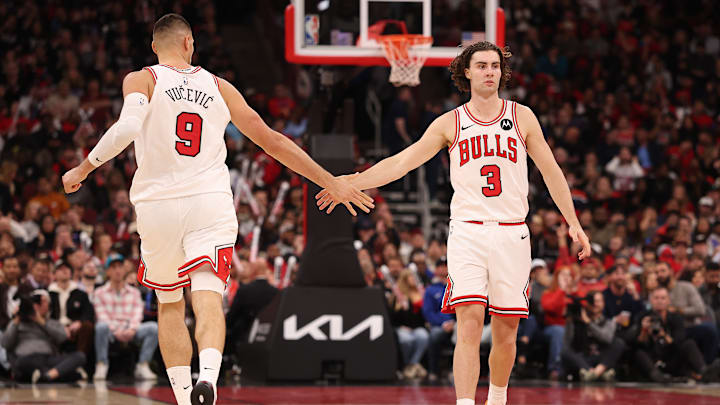The Chicago Bulls hardly resemble an Eastern Conference powerhouse. Their roster includes just one former All-Star, 35-year-old Nikola Vučević, and aside from Vooch, only one other player has ever averaged 20 or more points per game—Coby White.
Yet the Bulls are 5-1 and sit atop the Eastern Conference standings. Josh Giddey is playing like an All-Star, averaging 22.2 points, 9.3 rebounds, and 8.7 assists, but this terrific start has been a team effort through and through. The Bulls’ cohesion and selflessness have been unmatched, proving more impactful than pure star power.
Nonetheless, Chicago’s playstyle and personnel have proved just as—if not more—impactful. The Bulls’ uptempo, space-and-pace, drive-and-kick offense has compensated for their lack of star power, a balance made possible by the team’s blend of unique personnel.
Bulls use size to gain a competitive edge
The Bulls boast impressive size, led by their 6-foot-8 playmaker, Josh Giddey. The jumbo-sized guard’s grab-and-go ability elevates Chicago’s offense, allowing it to generate scoring opportunities without the need for a set play. As a result, the Bulls’ transition game was a major advantage last season and continues to be one this year.
Chicago’s size advantage doesn’t end with Giddey. When Coby White returns, he’ll be the Bulls’ smallest starter at 6-foot-5. The rest of the lineup features 6-foot-5 Isaac Okoro (225 pounds), 6-foot-10 Matas Buzelis, and 6-foot-10 Nikola Vučević, who weighs 260 pounds.
Of course, 6-foot-1 Tre Jones is currently filling White’s role, but he remains Chicago’s smallest rotation player by a wide margin. The rest of the bench ranges from 6-foot-5 to 6-foot-10.
Chicago has prioritized size and versatility—a trend the rest of the NBA is beginning to follow. NBA pundit Jake Fischer recently noted that teams were eager to start the season after adding size in the offseason. He highlighted rising offensive rebounding rates and the clear need for multiple rim protectors as the main reasons teams are gravitating toward bigger lineups.
As it stands, Chicago doesn’t excel in either category. The Bulls rank 19th in both offensive rebounds and blocks per game. Yet, unlike other teams that employ multi-big lineups, such as the Dallas Mavericks, Chicago isn’t sacrificing other positions to do so.
Chicago is loaded with size across its roster and seems determined to continue the trend after drafting 6-foot-10 Noa Essengue in June, who is projected to start alongside 6-foot-10 Matas Buzelis at forward. Once Essengue is ready—and the Bulls settle on their next starting center—Donovan could field a lineup with four players standing 6-foot-8 or taller.
The Bulls aren’t just built for the present—they’re built for the future. Fischer also highlighted teams’ efforts to emulate the depth and pace of the Indiana Pacers and Oklahoma City Thunder, a blueprint Chicago has already perfected.
